
Adam Gottlob Oehlenschläger was a Danish poet and playwright. He introduced romanticism into Danish literature. He wrote the lyrics to the song Der er et yndigt land, which is one of the national anthems of Denmark.

Valby is one of the 10 official districts of Copenhagen, Denmark. It is in the southwestern corner of Copenhagen Municipality, and has a mixture of different types of housing. This includes apartment blocks, terraced housing, areas with single-family houses and allotments, plus the remaining part of the old Valby village, around which the district has formed, intermingled with past and present industrial sites.

Michael Gottlieb Birckner Bindesbøll was a Danish architect active during the Danish Golden Age in the first half of the 19th century. Most known for his design of Thorvaldsens Museum in Copenhagen, he was a key figure in the stylistic shift in Danish architecture from late classicism to Historicism. He was the father of the designer Thorvald Bindesbøll and the textile artist Johanne Bindesbøll.

Johannes Emil Gnudtzmann was a Danish architect working in the Historicist style. His most notable works are St. Paul's Church and the extension of the Royal Veterinary and Agricultural University's main building, both in Copenhagen. He was the father of Kaj Gnudtzmann.
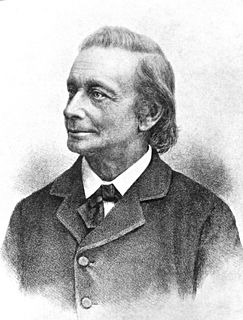
Jens Christian Hostrup was a Danish poet, dramatist and priest. Comforting and encouraging the people, he created poems that filled the hearts of his compatriots. His precise personal and environmental descriptions, as well as succinct dialogue, were welcomed by the critics and contemporaries. His dramas were on current topics such as feminism, free love and home, maybe one of the reasons why he often used the pseudonym Jens Kristrup (Christrup).
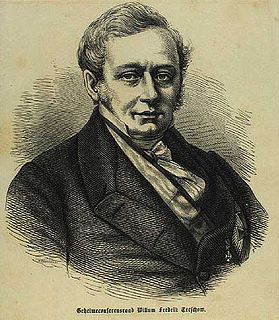
Vilhelm Frederik Treschow (15 September 1786 – 2 April 1869 was a Danish supreme court attorney, politician, landowner and philanthropist. He founded Treschows Stiftelse in Copenhagen.
Michael Treschow was a Danish Supreme Court justice and prefect of Roskilde County who was ennobled by letter patent in 1812. He was the father of Frederik Treschow.
Victoria Boline Frederikke Jensen (1847–1930) was a Danish deaconess and nursing supervisor. From 1914, she headed the Danish Deaconess Institute, succeeding Sophie Zahrtmann. She was also the driving force behind the establishment of a hospital in India by the Foreign Christian Missionary Society, known in Denmark as Ydre Mission.

Christianssæde is a manor house and estate located close to Maribo on the island of Lolland in southeastern Denmark.

Carl Wilhelm Thalbitzer was a Danish landowner and politician. He was a member of the 1848 Danish Constituent Assembly.

Johan Cornelius Tuxen was a Danish naval officer, politician, editor and writer. He was a member of the Folketing from 1864 to 1879.

Falkensteen is a manor house located five kilometres south of Slagelse, Denmark. The current Neoclassical main building was built for Georg Frederik Ditlev Koës in 1775. It was listed on the Danish registry of protected buildings and places in 1950. A half-timbered barn from 1864 is also listed.

Sankt Annæ Plads 7 is a listed property on Sankt Annæ Plads in the Frederiksstaden neighbourhood of central Copenhagen, Denmark. The Copenhagen Masons' Guild has been based in the building since 1929. It was listed on the Danish registry of protected buildings and places in 1932.
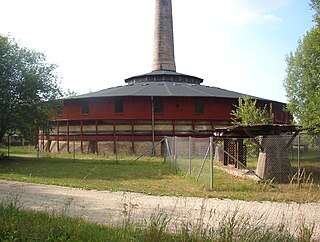
Nivaagaard Brickworks was one of two major brickworks at Nivå in North Zealand, Denmark. Its former Hoffmann kiln was listed on the Danish registry of protected buildings and places in 1985 and is now operated as a museum under the name Ringovnen.

Hakkemose Brickworks was a Danish brickyard and ceramics factory located at Taastrup, Denmark. The central lake in Hakkemosen is its former clay pit.
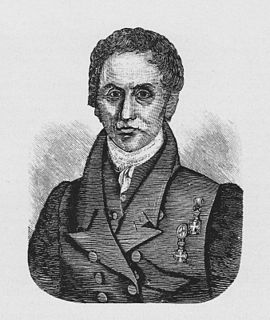
Urban Bruun Jürgensen was a Danish watchmaker. His company lived on and was called Jules Jürgensen after one of his two sons and is based in Switzerland.

Bianco Luno was a Danish book printer. His printing business, Bianco Lunos Bogtrykkeri, was at the time of his death in 1852 the largest company of its kind in Denmark. The street Bianco Lunos Allé in Frederiksberg is named after him.
Bernhard Seidelin (1820-1863) was a Danish architect. His most notable works include Helsingør station and Nyboder Girls' School.

Rogert Møller was a Danish architect and credit union manager. He was as an architect mainly active in the Vesterbro district of Copenhagen, designing many residential buildings during the population boom of the late 19th century. He worked for Østifternes Kreditforening from 1876 and served as chief technical officer from 1904.
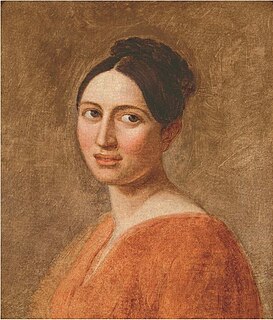
Sophie Wilhelmine Bertha Ørsted was a Danish socialite and muse. Brought up in a literary environment in Copenhagen, she was the sister of writer Adam Oehlenschläger (1779–1850) and was married to jurist Anders Sandøe Ørsted (1778-1860). She became an inspiration for others, including the poet Jens Baggesen (1764–1826). She died of abdominal complications when she was only 35.


















